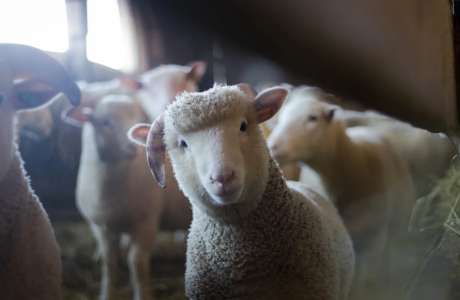Experts weigh in after shocking new bird flu discovery: ‘Globally, we continue to see…’
By
Maan
- Replies 4
Diseases jumping between species have long been a cause for concern, raising questions about how infections spread and evolve.
A recent case in northern England has sparked fresh discussions among experts, as a routine surveillance effort led to an unexpected discovery.
What followed has added to growing concerns about the global impact of this disease.
A case of bird flu in northern England has raised fresh concerns after a sheep tested positive for the virus—the first known instance of its kind worldwide.
The British government confirmed the detection of highly pathogenic avian influenza (H5N1) in a ewe, adding sheep to the growing list of mammals affected by the disease.
Over the years, H5N1 has been detected in a range of mammals, including dairy cows, dogs, cats, dolphins, seals, bears and even tigers.
Authorities discovered the case during routine monitoring of farm animals in Yorkshire, where outbreaks had already been confirmed in captive birds.
‘The case was identified following routine surveillance of farmed livestock on premises in Yorkshire where highly pathogenic avian influenza (H5N1) had been confirmed in other captive birds,’ the British government said.
The infected sheep showed signs of mastitis, an inflammation of the udder, but no other symptoms were noted.
The animal was culled, and no further infections were detected within the flock.
Following outbreaks among dairy cows in the United States, Britain’s rural affairs ministry introduced monitoring of livestock kept alongside infected birds.
Dr Meera Chand, Emerging Infection Lead at the UK Health Security Agency, acknowledged that mammals were susceptible to the virus but maintained that human transmission remained unlikely.
‘Globally, we continue to see that mammals can be infected with avian influenza (H5N1).’
‘However, current evidence suggests that the avian influenza viruses we’re seeing circulating around the world do not spread easily to people—and the risk of avian flu to the general public remains very low.’
While there have been cases of bird flu in humans, symptoms have varied from mild to severe, with fatalities occurring in rare instances.
So far, there have been no confirmed cases of human-to-human transmission.
In a previous story, authorities imposed strict new rules as they raced to contain a bird flu outbreak.
The growing spread of the virus has sparked urgent efforts to prevent further transmission.
Read more about the containment measures and their impact here.

As H5N1 continues to spread among different species, what impact do you think this could have on livestock and public health? Let us know your thoughts in the comments.
A recent case in northern England has sparked fresh discussions among experts, as a routine surveillance effort led to an unexpected discovery.
What followed has added to growing concerns about the global impact of this disease.
A case of bird flu in northern England has raised fresh concerns after a sheep tested positive for the virus—the first known instance of its kind worldwide.
The British government confirmed the detection of highly pathogenic avian influenza (H5N1) in a ewe, adding sheep to the growing list of mammals affected by the disease.
Over the years, H5N1 has been detected in a range of mammals, including dairy cows, dogs, cats, dolphins, seals, bears and even tigers.
Authorities discovered the case during routine monitoring of farm animals in Yorkshire, where outbreaks had already been confirmed in captive birds.
‘The case was identified following routine surveillance of farmed livestock on premises in Yorkshire where highly pathogenic avian influenza (H5N1) had been confirmed in other captive birds,’ the British government said.
The infected sheep showed signs of mastitis, an inflammation of the udder, but no other symptoms were noted.
The animal was culled, and no further infections were detected within the flock.
Following outbreaks among dairy cows in the United States, Britain’s rural affairs ministry introduced monitoring of livestock kept alongside infected birds.
Dr Meera Chand, Emerging Infection Lead at the UK Health Security Agency, acknowledged that mammals were susceptible to the virus but maintained that human transmission remained unlikely.
‘Globally, we continue to see that mammals can be infected with avian influenza (H5N1).’
‘However, current evidence suggests that the avian influenza viruses we’re seeing circulating around the world do not spread easily to people—and the risk of avian flu to the general public remains very low.’
While there have been cases of bird flu in humans, symptoms have varied from mild to severe, with fatalities occurring in rare instances.
So far, there have been no confirmed cases of human-to-human transmission.
In a previous story, authorities imposed strict new rules as they raced to contain a bird flu outbreak.
The growing spread of the virus has sparked urgent efforts to prevent further transmission.
Read more about the containment measures and their impact here.
Key Takeaways
- A sheep in northern England tested positive for H5N1 bird flu, the first recorded case in its species.
- The British government detected the virus during routine monitoring on a farm where infected birds had already been found.
- The ewe showed signs of mastitis, was culled, and no further infections were detected in the flock.
- Experts say mammals can catch H5N1, but the risk to humans remains low, with no confirmed human-to-human transmission.
As H5N1 continues to spread among different species, what impact do you think this could have on livestock and public health? Let us know your thoughts in the comments.








